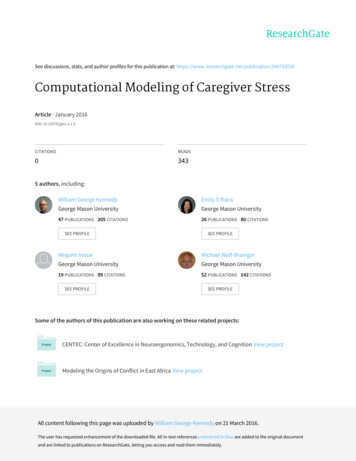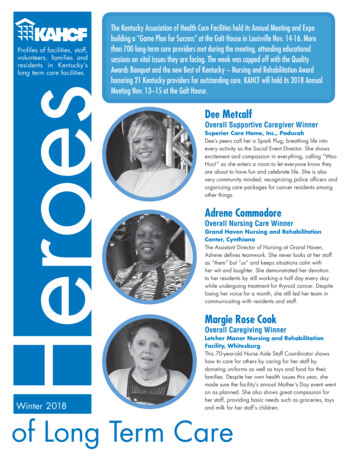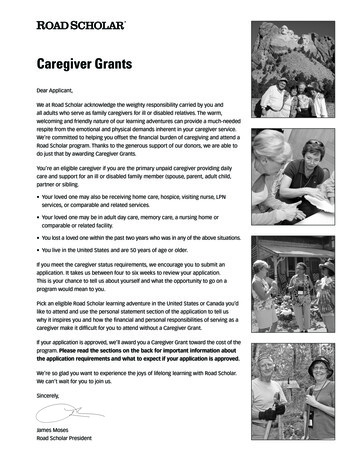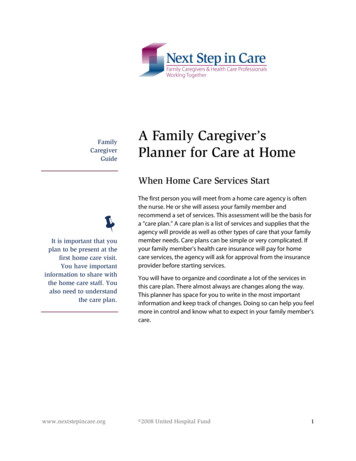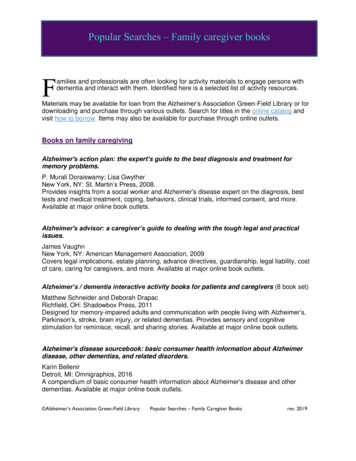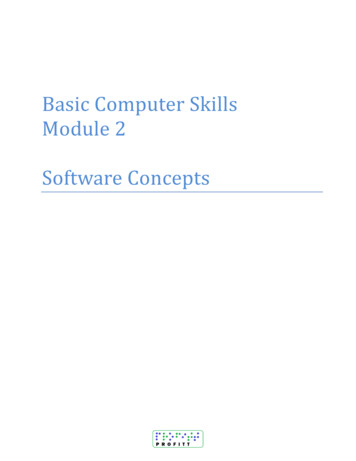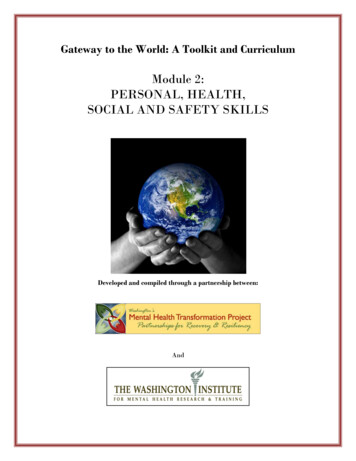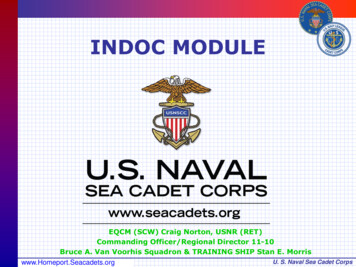
Transcription
National Caregiver Training ProgramCaregiver WorkbookNational Caregiver Training ProgramCaregiver WorkbookModule 3: Caregiver SkillsIn this module we will review some of the skills that will assist you in caring for theVeteran. As a Caregiver, you are an essential part of the Veteran’s health care team inmonitoring physical health and well-being. The skills that will be reviewed in this moduleare: Vital SignsInfection Control/AvoidanceSkin CareMedication ManagementPain ManagementAlthough the Veteran you care for may not need daily monitoring in these areas, theinformation presented in this module can be helpful to .S. Departmentof Veterans Affairs
National Caregiver Training ProgramCaregiver WorkbookNational Caregiver Training ProgramCaregiver WorkbookVital SignsVital signs measure the basic functions of the body. It’s helpful to monitor the Veteran’svital signs to detect any changes in the status of the Veteran’s health. Some basic vitalsigns that are commonly tracked include: Temperature; body temperature in degrees.Pulse (or Heart Rate); beats per minute.Respirations (breathing rate); breaths per minute.Blood pressure; not covered in this lesson.To take vital signs you will need a thermometer and a watch with a second hand. Youmay want to have a pen and pad of paper nearby so you can write down the results.Using a calculator to find the “average” can help to speed up the process and ensureaccurate results. Sharing accurate vital sign records with the Veteran’s Primary CareTeam can help them make better .govU.S. Departmentof Veterans Affairs
National Caregiver Training ProgramCaregiver WorkbookNational Caregiver Training ProgramCaregiver WorkbookBody TemperatureThe normal body temperature can range from 97 to 99.6degrees Fahrenheit. Knowing the Veteran’s usualtemperature can help you determine when there might be aproblem, such as an infection. When a Veteran has aninfection or illness, the body temperature can rise. A bodytemperature over 104 degrees can be dangerous. It’s best tocall the Primary Care Team if the Veteran has a temperaturethat is one degree above his/her normal body temperature, unless the Primary CareTeam has given you other instructions.Factors that influence body temperature include environment, exercise, age anddrinking either hot or cold fluids just before taking the temperature. All of these canaffect the body temperature readings so:Ask the Veteran not to drink anything 10 to15minutes prior to taking his/her body temperature.Measuring temperature with a digital thermometer is the recommended method fortaking an oral temperature.Some households may still have mercury-in-glassthermometers. The production of thesethermometers has ceased in the United States dueto the hazardous properties of spilled mercury, ifthe glass thermometer is broken.If a mercury thermometer breaks, you can clean itup yourself using precautions. Wear gloves anduse paper towels to clean up the mercury. If the mercury spill involves glass pieces fromthe thermometer, use tweezers to safely pick up any broken glass, placing the glass in aplastic container. Place the broken product and all materials used to clean up themercury (gloves, paper towels, tweezers etc.) in sealable plastic containers or airtightsealable bags. Place the plastic containers or bags inside a second plastic container orbag to provide additional containment protection. Seal each bag or tighten each lidsecurely so that liquid and vapors will be contained.Never use a vacuum cleaner, mop or broomto clean up a mercury spill!Heat from the vacuum’s motor will increase the amount of mercury vapor in the S. Departmentof Veterans Affairs
National Caregiver Training ProgramNational CaregiverCaregiverTrainingWorkbookProgramCaregiver WorkbookMops and brooms will spread the mercury, making proper cleanup more difficult andcostly. Never pour mercury down a floor drain, sink, toilet or any other drain as thedrainpipe itself will then be contaminated.InstructionsTo take an oral temperature, ask the Veteran to sit upright. If the Veteran must stay inbed, then it’s helpful for him/her to be in a sitting position.1.2.3.4.Ask the Veteran to open his/her mouth and lift up their tongue.Gently place the thermometer under the tongue.Have the Veteran close his/her mouth without biting on the thermometer.Push the start button, if you are using a digitalthermometer.5. The digital thermometer will beep when it isdone. It will show the Veteran’s temperature inFahrenheit degrees (leave a glass thermometerin place 3-5 minutes).Remember to clean thethermometerbefore storing . Departmentof Veterans Affairs
National Caregiver Training ProgramCaregiver WorkbookNational Caregiver Training ProgramCaregiver WorkbookPulse or Heart RateThe pulse gives you a sense of the health of the heart. Thepulse, or heart rate, is the number of times the heart beats inone minute. You may also check the rhythm of the heart andthe strength of the pulse. Having a watch with a secondhand or a stopwatch handy to measure pulse will be helpful.The normal heart rate can range from 60 to 100 beats perminute. Activity, stress, worry and anxiety, as well ascaffeine, nicotine and some medications can affect the heart rate. The heart rate canalso increase with pain or sickness. Familiarize yourself with the Veteran’s usual restingheart rate. This is the heart rate when the Veteran has not been participating in exerciseor heavy activity. Knowing the Veteran’s usual heart rate will help you to identify whensomething has changed.The pulse can be felt in several different places; however, we’ll concentrate on how totake the pulse at the wrist and the neck. If you need to know other methods, yourPrimary Care Team can help you.Instructions1. Have the Veteran sit up straight, resting his/her arm on a table or tray, if possible.Relax the hand and arm with the palm of the hand facing up toward the ceiling.2. Place a watch with a second hand where you will be able to see it.3. To take the pulse at the wrist, place the tips of the first and second fingers (indexand middle fingers) on the Veteran’s wrist about one inch below the thumb. Atfirst it may be helpful to move your fingers gently until you feel the pulse.4. To take the pulse at the neck, you will use your first and second fingers. Placethem on the side of the neck, about half way between the ear and chin, wherethe chin meets the neck, just to the side of the windpipe.5. For either technique, count the pulse for 60 seconds. You can also count for 30seconds and multiply the pulse by 2.If you are unsure, try it again. You can also take the pulse three times and then averagethem. To do this, add up the pulse readings from all three measurements, then divide bythree. This will be the average pulse .S. Departmentof Veterans Affairs
National Caregiver Training ProgramCaregiver WorkbookNational Caregiver Training ProgramCaregiver WorkbookLet’s Give it a Try!Ask a friend or family member if you can practice taking their pulse.Wrist PulseNeck PulseRate:Rate:Date:Date:Time:Time:When you are taking the pulse, you can also be aware of the rhythm of the beats—ifthey are regular or seem to skip.Write your description of the pulse you just took.Wrist Pulse:Neck Pulse:You can also be aware of the strength of the pulse—is it strong or weak?Write your description of the pulse you just took.Wrist Pulse:Neck Pulse:If you think that the heart rate has changed, for instance increased unexplainably, youcan wait a few minutes and then take it again.Wrist PulseNeck er.va.govwww.caregiver.va.govU.S. Departmentof Veterans Affairs
National Caregiver Training ProgramNational CaregiverCaregiverTraining WorkbookProgramCaregiver WorkbookAffects on Pulse RateThe pulse rate can be affected by some medications.Ask the primary care team if medications the Veterantakes will affect his or her pulse. Other things thatmay affect the pulse rate are: Activity and exercise.Stress, worry and anxiety.Caffeine, nicotine.Pain.Illness.It’s best to contact the Primary Care Team immediately if there isany significant change that cannot be explained. These changesmay include: The pulse is very different from the Veteran’s usual reading. A heart rate that is over 100 and the Veteran has not been exercising, drinkingcoffee, or doing anything else that might cause this to happen. The heart rate is irregular or unusually rapid, or if the Veteran is experiencing chestpain, dizziness, fainting, lightheadedness or shortness of breath. If the Veteran feels cold and sweaty—this could be diaphoresis (excessive sweating)and can be a sign of serious heart govU.S. Departmentof Veterans Affairs
National Caregiver Training ProgramCaregiver WorkbookNational Caregiver Training ProgramCaregiver WorkbookRespirationsRespirations are the number of times the Veteran breathes in a minute. To measurerespirations, you count the number of times the chest rises.Like the pulse, the breathing rate can be changed by exercise, strong emotion or illness.The normal rate for respirations is16-24 breaths per minute.When we know that our breathing is being watched, we tend to change our breathingpattern. For this reason, try not to tell the Veteran that you are going to count theirbreaths. Respirations can be counted while taking the pulse.Instructions1. After taking the pulse, keep your fingers in place as if you are still counting thepulse.2. Count how many times the chest rises and falls for one minute. If you prefer, youcan count for 30 seconds and then multiply by two.3. When you are counting respirations, you can also listen to the breathing. Does itsound clear or congested?Contact the Primary Care Team if there is any significant change thatcannot be explained. Some examples of when to call include: If you hear any gurgling or chest congestion. If the Veteran is complaining of shortness of breath, as if he/shecannot catch his/her breath.Let’s Give it a Try!Ask a friend or family member if you can practice taking their pulse then also check theirrespiration and write down your results.Wrist 00www.caregiver.va.govwww.caregiver.va.govU.S. Departmentof Veterans Affairs
National Caregiver Training ProgramCaregiver WorkbookNational Caregiver Training ProgramCaregiver WorkbookRecording Vital SignsWriting vital signs down each time you take them will help you keep an accurate record.Vital signs may vary slightly each time you take them. A little difference in the readingseach time is to be expected. It is easiest to use a chart so that you can see when thereis a real change.Date/TimeTemperature(Degrees)Pulse (Beats/Min)Respiration(Breaths/Min)April 188:00am98.66820April 1812:00pm98.66419Remember, you are an important part of the Veterans Care Team. Measuring vital signsaccurately can really help in keeping the Veteran healthy.MyHealtheVetMy HealtheVet is a free, online personal health record provided by VA, available 24/7where ever there is Internet access. This site offers valuable information on healthconditions, wellness reminders, and the Veteran’s schedule of medical appointments aswell as the ability to send secure messages to the Veteran’s health care team. BothCaregivers and Veterans can register to participate on this site. After registering on thesite, the Track Health tab at the top of the page will allow you to record and maintain arecord of the Veteran’s vital signs and other important measures of health such as bloodpressure, cholesterol and other laboratory tests.After registering on the site, the Track Health tab at the top of the page maintains arecord of the Veteran’s vital signs and other important r.va.govU.S. Departmentof Veterans Affairs
National Caregiver Training ProgramCaregiver WorkbookNational Caregiver Training ProgramCaregiver WorkbookVital Signs ChartDate/TimeTemperature(Degrees)Pulse iver.va.govwww.caregiver.va.govU.S. Departmentof Veterans Affairs
National Caregiver Training ProgramNational CaregiverCaregiverTrainingWorkbookProgramCaregiver WorkbookInfection ControlStandard Precautions, otherwise known as Universal Precautions, were developed inthe early 1980’s to reduce the risk of infection. They are designed to protect bothcaregivers and care recipients from transmitting disease.What are Universal Precautions?Universal Precautions are practices designed to prevent the spread of infection fromblood that has been infected with bacteria or viruses, also known as bloodbornepathogens. The intent of Universal Precautions is to isolate the disease, not the personand to prevent exposure of Caregivers and Veterans to these bacteria and viruses.Universal Precautions are a two-way street. It’s helpful to think of all body fluids ashaving the potential to be infected. As a Caregiver, you may not always know when theVeteran has been exposed to a new virus or bacteria. Also, he/she may be moresusceptible to infection due to their injury; using Universal Precautions will protect theVeteran you care for from any viruses or bacteria that you may carry.Bloodborne PathogensBloodborne pathogens are infectious agentsthat are passed from person to personthrough blood or other body fluids.Bloodborne pathogens include but are notlimited to HIV/AIDS, Hepatitis B andHepatitis C. If the Veteran has one of theseinfections, it is important that you protectyourself from contracting it.Keep in mind that other body fluids such asdrainage from sores, pus, mucus from thenose or throat, sputum, vomit etc and fecalmaterial can be a source for bacteria,viruses or other infectious agents to transmit infections including but not limited to thefollowing: Staph and Strep Infections.MRSA (Methicillin-Resistent Staphylococcus Aureus).Hepatitis A.Influenza.Other .va.govU.S. Departmentof Veterans Affairs
National Caregiver Training ProgramCaregiver WorkbookNational Caregiver Training ProgramCaregiver WorkbookFor this reason, it’s helpful for you to use gloves and Universal Precautions whenhandling these fluids as well as blood and fluids with visible blood in them. The intent ofUniversal Precautions is to isolate the disease―not the person―and to preventexposure of Caregivers and Veterans to these bacteria and .govU.S. Departmentof Veterans Affairs
National Caregiver Training ProgramNational CaregiverCaregiverTraining WorkbookProgramCaregiver WorkbookUsing BarriersBarriers prevent the spread of a disease and include equipment or clothing whichprotect your skin or airway from the source of infection. Gloves, face masks, safetyglasses and surgical gowns are all different types of barriers, also known as PersonalProtective Equipment or PPEs.Glove UseConsider wearing properly-fitting disposable gloves any time you might be exposed tobody fluids, particularly during the following situations: Assisting the Veteran with toileting and other personal care tasks. Changing diapers or Depends (as applicable). Wiping a family member’s nose or mouth.Cleaning up vomit, urine, or feces.Cleaning or bandaging a cut or a wound.Cleaning contaminated surfaces, like chair arms, table tops, counters.Remember to remove and discard your disposable gloves after each use or after eachtask.Face MasksYou may choose to wear a face mask if you are or have recently been sick with a cold,the flu or other illness since the Veteran may be more susceptible to infection.Other Personal Protective EquipmentOther Personal Protective Equipment includes gowns and eye protection (safetyglasses). Gowns and eye wear are generally used to protect the Caregiver from splashes ofblood or body fluids. Caregivers may choose to use these for wound vU.S. Departmentof Veterans Affairs
National Caregiver Training ProgramCaregiver WorkbookNational Caregiver Training ProgramCaregiver WorkbookHand WashingViruses and bacteria are commonly spread through contact with the hands whether bysneezing or coughing, handling raw foods such as chicken, petting animals or changinga diaper. Hand washing is the single most effective way of preventing and controllingthe spread of infection.InstructionsEncourage all family members to use the following hand washing tips:1. Keep clothing from touching the sink.2. Moisten hands using warm, running water.3. Vigorously scrub hands with soap for 15-30 seconds. Wash the back, palm andfingers of each hand. Wash between fingers. Clean under nails.4. Rinse hands under running water.5. Dry hands well using a paper towel.6. Use the towel or your elbow to turn off the water.Children (and adults, for that matter) can be encouraged to soap their hands while theysing the song “Happy Birthday to You” twice, which is about the time needed to scrubhands .va.govU.S. Departmentof Veterans Affairs
National Caregiver Training ProgramNational CaregiverCaregiverTrainingWorkbookProgramCaregiver WorkbookRemember, it’s helpful to wash your hands: Before and after work.Before and after use of disposable gloves.After handling soiled (dirty) items.After using the restroom.After assisting a person in the restroom. After diapering or applying/changing Depends .Before preparing or serving food.After any contact with body fluids.When your hands are dirty.Alcohol-based Hand SanitizersThese are an alternative to washing hands with soap and water. Although washing withsoap and water is preferred, hand sanitizers can be useful when out in public, in the caror in other situations away from home. If you choose to use a hand sanitizer, try toselect one that contains at least 60% alcohol.Other PrecautionsIn addition to taking precautions against bloodborne pathogens and other infections, trythe following tips to help protect you, the Veteran and others from becoming ill: Dispose of needles, glucose sticks and other sharp items in a hard plastic sharpsdisposal box. Avoid sharing any items that touch another person’s mouth such as cups, eatingutensils, thermometers or toothbrushes. Encourage your family not to share any items used for personal care such ashairbrushes, cosmetics, razors or eyeglasses. Cover your nose and mouth with a tissue when sneezing or coughing and dispose ofthe tissue in a trash bag immediately. If no tissues are available cough or sneezeinto the crook of your elbow. Keep wounds clean and covered with a bandage until healed. Clean and disinfect laundry soiled with body fluids, kitchen surfaces, bedpans r.va.govU.S. Departmentof Veterans Affairs
National Caregiver Training ProgramCaregiver WorkbookNational Caregiver Training ProgramCaregiver WorkbookVaccinationsMaintaining your own health and those of other family members is very important tominimize the Veteran’s susceptibility to illnesses. Talk with your family and members ofthe caregiving team periodically to ensure all of their immunizations are up-to-date,particularly annual flu vaccines.Skin CareHealthy skin protects you from bacteria and foreign objects. It contains nerve endingsthat let you know if something is cold or hot, sharp or dull, or hard or soft. It also helps inregulating your body’s fluids and temperature. Healthy skin minimizes the Veteran’ssusceptibility to infections. Even with the best care though, the Veteran may experiencebed sores, also called pressure ulcers or pressure sores which can occur with evenshort periods in a wheelchair or bed.What are Pressure Sores?Pressure sores are places on the skin that become irritated due to lack of movement,reduced or loss of sensation in the skin, or reduced blood flow.How do Pressure Sores Develop?These types of sores are caused by pressure on a bony area from lying or sitting in thesame position for long periods of time. These can also be caused by sitting or lying onhard objects, bruises, the skin being wet or moist for long periods of time, or the frictionof sheets or clothing rubbing an area of skin when the Veteran is confined to a bed orchair. Pressure sores can also develop under oxygen or feeding tubes, around casts,drainage tubes, neck collars, or other medical devices that touch the skin with too muchpressure. Pressure sores can quickly become infected and result in serious medicalcomplications, at times requiring hospitalization and surgery.Where do Pressure Sores Form?These following graphics and photographs show the stages of pressure soredevelopment. Pressure sores typically start out as reddened skin, form a blister, then anopen sore and finally a crater. See Figures 1 and 2 on the next two ovU.S. Departmentof Veterans Affairs
National Caregiver Training ProgramNational CaregiverCaregiverTraining WorkbookProgramCaregiver WorkbookFigure 1: Areas on the Body Most Susceptible to Pressure Sores (http://www. ncbi.nlm.nih.gov)Pressure sores form on the back of the head, ears, shoulder blades, elbows, tailbone,buttocks, hips and ovU.S. Departmentof Veterans Affairs
National Caregiver Training ProgramNational CaregiverCaregiverTraining WorkbookProgramCaregiver WorkbookFigure 2: Stages of Pressure Sore or Ulcer DevelopmentsStage 1Healthy skin has active blood flow just below the surface. If redness on the skin doesnot go away after it is lightly touched by the thumb or finger, then a pressure sore isstarting to develop. In Veterans with darker skin, discoloration of the skin, warmth,edema, or hardness may also be indicators of development.Stage 2The skin blisters or forms an open sore and may look red and irritated. The ulcer maylook like an abrasion, blister, or very shallow crater.Stage 3The skin may now look like a crater with damage to the tissue below the skin.Stage 4The pressure ulcer is so deep that there is damage to the muscle and bone, andsometimes to tendons and govU.S. Departmentof Veterans Affairs
National Caregiver Training ProgramNational CaregiverCaregiverTraining WorkbookProgramCaregiver WorkbookAlthough it may be tempting to massage the area of the ulcer oruse donut-shaped or ring-shaped cushions to relieve the pressure,these actions can actually be harmful. It’s best to contact theVeteran’s Primary Care Team if the skin forms an open sore,particularly if there are any signs of infection including an odor fromthe ulcer, redness or tenderness around the ulcer or the skin iswarm and swollen.Prevention: Performing Skin InspectionsRoutine skin inspections are helpful in preventing pressure sores and reducing thechance of skin infections. If the Veteran is confined to bed or frequently in a wheelchair,try to check his/her skin at least twice a day—when getting dressed in the morning andundressed at night. Look for redness over bony areas that does not go away when theVeteran is repositioned, blisters, rashes, areas that feel hot to touch, or areas that areoften moist with sweat or urine. Lift skin folds to check creases in the skin and areasthat are not easily visible. Examine bony areas like heels, knees, hips and elbows aswell.Healthy Skin Care PracticesThe old adage that an ounce of prevention is worth a pound of cure certainly applies todeveloping a system to maintain healthy skin. Help the Veteran keep his/her skin clean and dry. Use skin lotion on dry skin, rubbing it in gently, especially after bathing, when theVeteran is in a room with dry heat, or any other time you notice his/her skin is dry. Ensure the Veteran drinks plenty of fluids daily and maintains a healthy diet,including foods rich in vitamins A, E, B6, such as fresh fruits and vegetables, dairyproducts and fish. Keeping the Veteran’s skin, bed sheets and clothing clean and dry can be helpful. Check the Veteran’s feet carefully when wearing new shoes to ensure they are nottoo tight, too large, or rubbing hot spots on the vU.S. Departmentof Veterans Affairs
National Caregiver Training ProgramNational CaregiverCaregiverTraining WorkbookProgramCaregiver WorkbookPrevention: Keep Moving!If the Veteran is able, be sure he/she gets up andmoves around several times a day.If the Veteran cannot get up without assistance, besure that his/her position is changed several times aday.If the Veteran is in a wheelchair and has upper bodymobility, he/she can do “wheelchair push-ups” orpressure lifts as much as every 20 minutes.This is done by securing the lock on the chair wheels,releasing the security belt, and having the Veteranpush down on the top of the wheels with their armslifting the weight of their lower body and lifting theirbottom off the chair seat. Ask the Veteran to hold thisposition momentarily and then relax back into theseat. This exercise may be repeated during the dayas recommended by the Primary Care Team.Relieve Pressure on Bony AreasEncourage the Veteran to change positions frequently to relieve pressure on bony areasof the body. If the Veteran is able, it’s helpful for him/her to spend time on his/herstomach at least once a day. A mobile person may turn once every 12 minutes whilesleeping.For a bedridden Veteran, a schedule of turningevery two hours at a minimum is best. If you cannot remember the turning schedule, then have it written on a notepad nearthe bed. If the Veteran is using a wheelchair, try to keep it adjusted properly, especially theheight of the foot pedals. Encourage the Veteran to be as active as possible,changing positions every two hours. The Veteran’s Primary Care Team or other provider can teach you the best positionsfor the Veteran given their specific injury condition or disability. Try to ensureclothes, socks and shoes fit properly and are not rubbing against the vU.S. Departmentof Veterans Affairs
National Caregiver Training ProgramNational CaregiverCaregiverTraining WorkbookProgramCaregiver WorkbookMedication ManagementDeveloping a good working relationship and open lines of communication with thePrimary Care Team is important to ensure that the Veteran’s medications are managedeffectively and common errors are avoided such as: Taking the wrong dosage.Not taking the medication properly.Stopping medications prematurely.Mixing prescription and over-the-counter drugs (OTC) that are not compatible.As the Caregiver, you are on the “front lines” and can document the Veteran’s responseto medications taken at home. Caregivers closely observe changes in mood, diet,sleeping habits and other factors that can inform the Primary Care Team’s approach totreatment and a.govU.S. Departmentof Veterans Affairs
National Caregiver Training ProgramNational CaregiverCaregiverTraining WorkbookProgramCaregiver WorkbookQuestions You Should Ask about the Veteran’s Medicines What is this medication for? How should the medication be taken? Should this be taken with or without food? Are there any foods that should be avoided? How long is the medication to be taken? How often? Daily? Twice per day?Does this medication need to be taken at certain times? Will this drug interact with the medications the Veteran is currently taking(including OTC medications)? Are there medications to be avoided while on this medicine? What are the possible side effects of this medication? What should we do if these occur? Can we do anything to avoid or minimize possible side effects? How will we know the prescribed medicine is working?Developing a Medication ListThe easiest method to track the Veteran’s medications is to make a list of all the drugnames, dosage and instructions for use. If you can, also include any over the counter(OTC) medications such as cold medications, or herbal supplements. You can createyour own list or download a sample from the Internet such as the VA’s RESCUEmedication card. It’s helpful to carry a copy in your wallet/purse, and post one on thefridge (especially if the Veteran is home govU.S. Departmentof Veterans Affairs
National Caregiver Training ProgramCaregiver WorkbookNational Caregiver Training ProgramCaregiver WorkbookManaging and Organizing the Veteran’s MedicationSometimes the best management of the Veteran’s medication is to ask the PrimaryCare Team if it is possible to minimize the number of different pills the Veteran is takingor at least limit the number of medicines taken twice a day or more frequently. In doingso, you can increase the likelihood that the Veteran will stick to the treatment schedule.It’s also helpful to routinely discuss the medications the Veteran is taking with thePrimary Care Team. Bringing all the prescriptions, OTC medicines, vitamins and herbalsupplements to the visit will keep the Primary Care Team informed of any changes inthe Veteran’s regimen.Using pillboxes is one of the most effective ways oforganizing the Veteran’s medicines. Those that havelabeled compartments for each day of the week andmultiple rows of compartments for medicines takenseveral times per day are particularly useful.In order to minimize the number of pharmacies theVeteran uses, ask your Caregiver SupportCoordinator about ordering prescription refillsthrough the VA’s program MyHealtheVet.Safety TipsKeep in mind the following safety tips in helping the Veteran man
Veteran. As a Caregiver, you are an essential part of the Veteran’s health care team in monitoring physical health and well-being. The skills that will be reviewed in this module are: Vital Signs Infection Control/Avoidance
